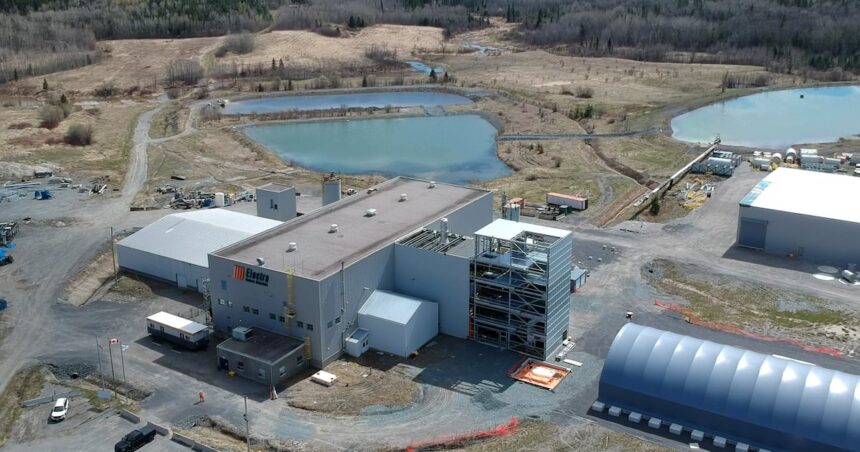I’ve spent the last week tracking the steady transformation happening along the shores of Lake Temiskaming, where Electra Battery Materials is building what’s poised to become North America’s only cobalt sulfate refinery. The project represents a significant push to establish a domestic battery supply chain that could reshape Canada’s role in the electric vehicle revolution.
The company recently hit a critical milestone in their development timeline, commissioning key mechanical systems at their facility in the town of Temiskaming Shores, Ontario. What makes this particularly noteworthy is how the project addresses a strategic vulnerability in North American manufacturing: our near-complete dependence on overseas processing for critical battery minerals.
“We are the first and only cobalt sulfate producer in North America,” Electra CEO Trent Mell told local media this week. “We’re producing material that will go into the cathode of a battery, and then ultimately into electric vehicles, energy storage, and our phones and laptops.”
The significance extends beyond just breaking ground on new infrastructure. Currently, China dominates global cobalt processing, refining approximately 70% of the world’s supply, according to data from the International Energy Agency. This concentration creates both supply chain vulnerabilities and ethical concerns, as a significant portion of raw cobalt comes from mining operations in the Democratic Republic of Congo with problematic labor practices.
Electra’s approach targets both issues simultaneously. By establishing local processing capabilities, they’re creating what industry analysts call “mining-adjacent value”—capturing more of the economic benefits that typically flow overseas after resources are extracted.
The refinery’s development comes amid surging demand projections for battery materials. BloombergNEF forecasts that by 2030, global demand for battery-grade cobalt could reach 270,000 metric tons annually, a substantial increase from current levels. Yet North America has remained notably behind in developing processing capacity for these materials.
What caught my attention during my research was how Electra is positioning its operation as more than just a processing facility. The company describes its approach as creating a “Battery Materials Park” that would eventually encompass recycling operations alongside refining.
“The refinery is just phase one,” explained Mell. “Phase two looks at battery recycling, and phase three would be nickel sulfate.”
This integration of recycling alongside new material processing represents a more circular approach to battery production—something that’s become increasingly important as governments and manufacturers grapple with the full lifecycle environmental impacts of electric vehicles.
The economic implications for Northern Ontario could be substantial. The project is expected to create approximately 100 jobs in a region traditionally dependent on resource extraction. But more importantly, it positions the area as a potential hub in the electrification supply chain.
Local officials have welcomed the development, with Temiskaming Shores Mayor Jeff Laferriere noting the project “represents exactly the kind of value-added processing that communities like ours have been seeking for decades.”
What makes the timing particularly relevant is how it aligns with both Canadian and American policy initiatives. The U.S. Inflation Reduction Act includes substantial incentives for electric vehicles containing materials processed in North America. Meanwhile, Canada’s Critical Minerals Strategy, released in 2022, specifically targets developments like Electra’s refinery for support.
The economics behind the facility are compelling. Processing cobalt closer to North American manufacturers reduces shipping costs and supply chain risks while potentially commanding a premium from automakers eager to demonstrate ethical and secure sourcing. Industry analysts at Benchmark Mineral Intelligence estimate that locally processed battery materials could command 10-15% premiums in the current market environment.
There remain hurdles, however. Building new refining capacity is capital-intensive, with Electra having secured approximately $60 million in government support alongside private investment. The project must also navigate stringent environmental regulations and technological challenges in producing battery-grade materials that meet manufacturer specifications.
Perhaps most challenging is the volatile nature of cobalt markets themselves. Prices have fluctuated dramatically in recent years, from peaks above $90,000 per metric ton to below $30,000. Battery manufacturers continue searching for ways to reduce cobalt content in their cells due to both cost and ethical concerns.
Despite these challenges, Electra’s progress represents something larger than a single facility—it’s a test case for whether North America can develop the midstream processing capacity needed to support ambitious electrification goals.
For communities across Northern Ontario, the project offers a glimpse of how traditional mining regions might transform alongside the energy transition. Rather than simply extracting resources for processing elsewhere, the model suggests a future where more of the value chain remains local.
As I drove away from the construction site, what struck me most wasn’t the scale of the physical infrastructure but rather the strategic significance of what’s being built. In a global race to secure battery supply chains, this relatively small facility in Northern Ontario represents a significant early move to address a critical manufacturing gap.
The cobalt that will eventually flow from this refinery won’t just power electric vehicles—it could help power a new chapter in Canadian manufacturing and resource development. Whether that potential is fully realized will depend on how successfully Electra navigates the technical, financial, and market challenges ahead.






